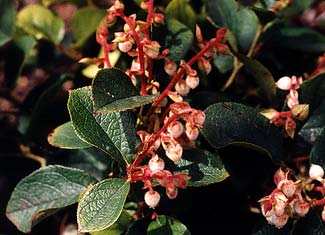 Salal:
Salal:
Hardy Northwest native
evergreen shrub
"Harmonious Powers with Nature work
On sky, earth, river, lake and sea;
Sunshine and cloud, whirlwind & breeze,
All in one duteous task agree."
-William Wordsworth
Salal (Gaultheria shallon) is so forgiving of conditions that it is always tempting to stretch its ideal preferences, placing it where it gets too much sun, or too little water, or otherwise in some location where it will perform so-so to okay, but not be at its finest.
Ideally it is in somewhat moist, well-draining loamy acidic soil in part sun to part shade, but the fact that it will do well in truly crappy soil often gets it relegated to parking margin plantings. It can tolerate quite a lot of dryness if it is growing in fir-shaded forests, but with the double-whammy of inadequate watering & bright sun, roadside salals will not show themselves to best effect.
 As it is a local native plant very frequently seen in the wild, it is easy to see the two conditions it chooses for itself when left to its own devices. It grows differently in each of the two types of sites it prefers.
As it is a local native plant very frequently seen in the wild, it is easy to see the two conditions it chooses for itself when left to its own devices. It grows differently in each of the two types of sites it prefers.Here on the Kitsap Penninsula, as elsewhere in the Northwest, it is found very often in dry areas at forest edges or along the edges of clearcuts & on roadsides, with only a little shade from Douglas firs. In such locations it is a foot or so tall, very scraggly, far-spreading over the ground, & roots itself in all directions just under the surface of the soil striving for its share of rainfall. It obviously likes this sort of situation as it spreads & spreads & is invariably present in just such locations. Yet the leaves become rusty, the height is stunted, & with such appearance they would not be anyone's top choice for a garden.
Its other favorite location is where it is most beautiful to behold: In deeper shade in autumn-through-winter moist conditions near the trunks of large trees, where it grows to six feet height, becoming shorter where it spreads away from the tree into more light. It's shiny dark green leaves become fairly compact, & the roots can go downward for several feet (which makes such deep-woods specimens pretty much impossible to dig up without injury).
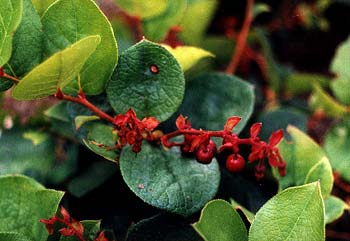 It's deep & wide root system means it returns rather quickly after forest fires. In some gardens it can be just a little hard to control & not easily gotten rid of if it is already widely established as a wild shrub spreading into gardens unwilling to share ground with unagressive cultivars. From young plantings it can take three years to get well established, but once it has taken off, it can potentially take over. Where a thick groundcover is desireable, salal might well be a better choice than ivy.
It's deep & wide root system means it returns rather quickly after forest fires. In some gardens it can be just a little hard to control & not easily gotten rid of if it is already widely established as a wild shrub spreading into gardens unwilling to share ground with unagressive cultivars. From young plantings it can take three years to get well established, but once it has taken off, it can potentially take over. Where a thick groundcover is desireable, salal might well be a better choice than ivy.I collected several salals from the wild & planted them at home in considerable shade. The first time I collected wild salals, they were taken from the edges of clearcuts where they root in a shallower manner; the roots were thick & woody & would run along underground for ten or thirty feet, of which I took only a foot or so of root.
Unfortunately these did not transplant all that well, either because the roots were injured, or from getting specimens that had adapted themselves to a sunnier spot & I put them in fairly deep shade.
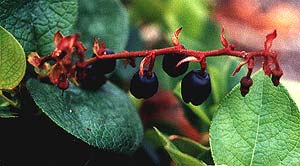 Of five plants, three took a year & a half to die limb by limb. The other two began as large specimens but had partial dieback that was pruned away, then later pruned again, until they finally began to take hold from a small size. In time the survivors became very nice & began to do perfectly well, but it is no sure-thing transplanting them from the wild, compared to nursery-grown starts that are easy as pi.
Of five plants, three took a year & a half to die limb by limb. The other two began as large specimens but had partial dieback that was pruned away, then later pruned again, until they finally began to take hold from a small size. In time the survivors became very nice & began to do perfectly well, but it is no sure-thing transplanting them from the wild, compared to nursery-grown starts that are easy as pi.I tried it a second time, taking starts from wild plants from a moister woodland edge, where salals were growing aggressively, spreading from the woods into a friend's garden. This time the roots weren't so woody & dry. They were thick, white roots that travelled underground for several yards so that young plants erupted in areas of cultivation. These plants with young roots were much more amenable to disruption & more easily transplanted into our own garden. I was more careful that they got watered in & cared for until established, & mulched with compost, so that these adapted quickly.
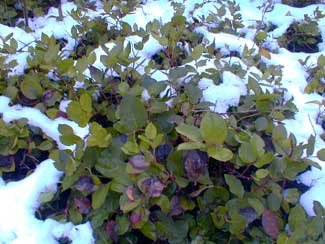 The woods throughout our county are in many places so thick with salal that it is the dominant groundcover, & evergreen huckleberries are the dominant mid-sized shrubs, & in the most wonderful sites the coast rhododendron is the dominant large substory shrub.
The woods throughout our county are in many places so thick with salal that it is the dominant groundcover, & evergreen huckleberries are the dominant mid-sized shrubs, & in the most wonderful sites the coast rhododendron is the dominant large substory shrub.Many places here on the Penninsula, if there are woods next to one's property, there will naturally be all the salal & huckleberries one will ever want. If there are trees on the property with salal & huckleberries already growing up close to the trunk, they might as well be left untouched, as it can be quite difficult to establish selected cultivars in the dry shade of hemlocks, cedars, & Douglas firs, yet such areas may already be densely green with native shrubs that can never be improved upon.
The wild evergreen huckleberries are always well-behaved & do not invade larger gardened areas when permitted to keep their self-selected spaces, but the salals do send out long underground runners & would love to take over everything if permitted. Their process is slow enough that they are not difficult to contain, but if abandoned to do their own choice, could spread too much. And if a gardener for whatever reasons decides not to keep the salal after all, it can be very difficult to eradicate since it regenerates from bits of root invariably left behind.
Salal is very affordable to purchase, & nursery-grown specimens will develop faster in a garden than will specimens transplanted from wooded areas or roadsides. Wanting more of them for a roadside garden, I bought several salals rootbound in gallon pots. One of these is shown in full May bloom at the top of the page. These have nothing to adapt to but are instantly hardy with just a little watering their first year, blooming & fruiting reliably.
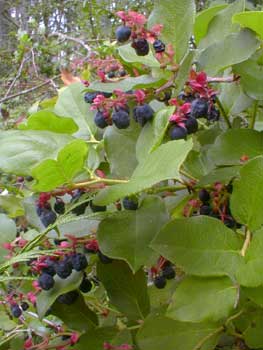 The dangly white to pinkish-white urn-flowers will be followed by edible berries (or fleshy sepals) in summer & fall. The second photo shows the fleshy sepals in June. The third photo shows them as red berries in early July when they are red. By the end of July or so, they have ripened to black, as shown in the August photo fourth on the page.
The dangly white to pinkish-white urn-flowers will be followed by edible berries (or fleshy sepals) in summer & fall. The second photo shows the fleshy sepals in June. The third photo shows them as red berries in early July when they are red. By the end of July or so, they have ripened to black, as shown in the August photo fourth on the page.If harvested it is best to wait until after one or two autumn frosts, which sweetens them up just a bit. The earliest salal harvests (before autumn frosts sweethen them) were traditionally mixed with the last of the huckleberries (often still harvestable as late as December), or red currants or Oregon grapes or red elderberries since insufficiently flavorful on their own.
It cannot be said that they are fabulously tasty all on their own, though sweeter than most autumn berries, & the Quileutes enjoyed them fresh-picked. Salal berries were an important food resource for coastal native peoples, who typically ate them as preserves in oolichan (bear fat), or pounded & dried to make salal-berry cakes storable in woven baskets. The dried cakes would need to be soaked in water before use, with seal or whale oil as a dipping sauce. The Haida mixed them with salmon eggs for a sweetish casarole.
For modern tastes, salals have been overlooked by by all but a minority of folks or families who go out on seasonal berry hunts & are more than commonly devoted to wild harvests. But salal really should be added to the berrying journeys. If cooked, sieved, & sweetened or spiced, they are certainly an improvement over cranberries. For no-excuses-needed home-canning, they are most enjoyable if they are used at a ratio of one-fourth to one-half cup salal to each two cups of such sweet choices as marion berries or blueberries. The ripe salal berries will add a wonderful depth to the flavor that'll be liked by everyone.
Salal wine recipes have been making the rounds among hobby winemakers, & the berries can also be made into a superior sauce used to glaze wild gamebirds or guinea hens, pheasant, or even turkey. At the Sooke Harbour House on Vancouver Island they use a salal sauce on grouse. Chief Sinclair Philip's recipe can be found in Northern Bounty: A Celebration of Canadian Cuisine or at a half-dozen recipe websites, if you don't want to be left to just eperiment.
But basically you can come up with your own variation with just a few pointers. You'll first need to steam & sieve the berries to get a couple cups of juice. Add just a couple teaspoons of maple syrup, grind in some fresh peppercorn, a couple tablespoons of vinegar, & enrich the overall flavor with a white wine, at least a full cup. This should be simmered for an hour or two, adding water so that it does not get too concentrated. The resultant sauce can be prepared in advance to keep in the refrigerator until the day a domestic or wild bird is handy.
Salal's popularity for gardens is in great part for its willingness to adapt to rocky or neglected roadside conditions, & that's what I needed it for too. But sometimes it feels regretable that it isn't more often treated to shady, loamy, moist but well-draining conditions, wherein it simply flourishes from day one without having to push at the edges of its adaptability.